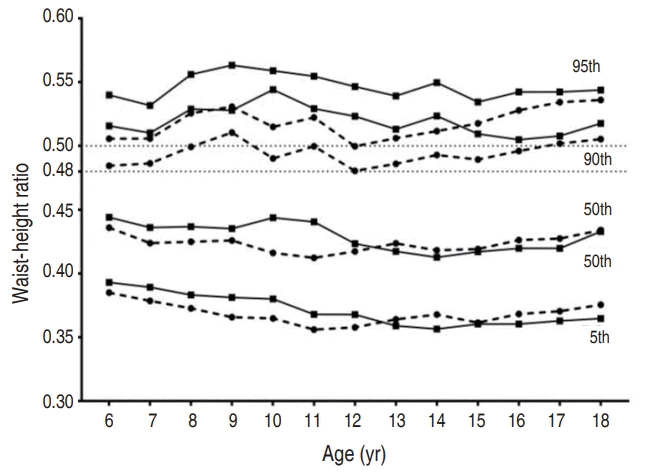Simple universal cutoff point of waist-height ratio for metabolic risk in Korean children and adolescents
Article information
The prevalence of obesity among children and adolescents has been increasing over 30 years, worldwide [1]. Pediatric obesity is closely related to metabolic syndrome during childhood and adolescence and adult obesity and cardiovascular risks. Recently, many studies from developed countries have reported that childhood obesity prevalence rates stabilized around the late 1990s and early 2000s. A similar trend was noted in Korea where the prevalence of childhood overweight and obesity stabilized from 2001 to 2012 for both boys and girls [2]. Similarly, Kim et al. [3] reported no significant secular change in waist circumference (WC) and the waist-height ratio (WHtR) over 10 years (2005–2015) in Korean children and adolescents. Nevertheless, obesity-related metabolic disorders, such as hyperlipidemia, type 2 diabetes mellitus, hypertension, and nonalcoholic fatty liver disease are recently emerging medical problems among children and adolescents.
It is somewhat difficult for parents to identify their children’s obesity, because normal weight children have less subcutaneous fat and lower normal body mass index (BMI) than do adults. However, early detection of obesity is the most important to prevent adult obesity and obesity-related cardiovascular risks in adulthood, because managing childhood obesity is challenging.
Several anthropometric measurements have been developed to define obesity. BMI is mainly used as obesity index because it is simply calculated using body weight and height; however, it reflects not only adiposity but also muscle mass. WC is widely used as an abdominal obesity index for adult and children [4]. Both are considered useful obesity indices to identify obesity-related cardiometabolic risks. However, the limitations of these 2 indices are ethnicity and sexspecificity in adults. For example, compared with men in western countries, a lower cutoff of BMI and WC are used for women in the Asian population. Furthermore, age and sex-specific percentiles should assist in diagnosis of obesity and abdominal obesity for children and adolescents. In a pediatric clinical setting, the pediatrician should use the BMI and WC percentiles for age and sex-specific tables for diagnosing pediatric obesity so that the patient’s indices can be compared to age and sex related cutoff points. Another limitation of WC as an abdominal obesity index is its association with height. Taller subjects have higher WC regardless of their lower cardiovascular risk.
Studies on alternative measurements for abdominal obesity have suggested that compared with BMI and WC, the WHtR calculated by dividing the WC by the height, has advantages in identifying cardiometabolic risk, thus downscaling the unfavorable effect of WC on cardiovascular risk [4-6].
According to systemic reviews among adults, a universal WHtR cutoff point of 0.5 is widely accepted as a screening tool for metabolic syndrome risks independent of sex and ethnicity in adults and even in children and adolescents [7].
Contrary to results from adults, inconsistent results on cutoff points for the associations between the WHtR with cardiovascular disease risk factors for children have been obtained. Studies have suggested that a WHtR cutoff point of 0.5 can be applied independent of sex and age in children. Studies from many countries validated that a universal WHtR≥0.5 is a better predictor of metabolic disorder risk in adolescents, independent of sex or age [8]. Another study suggested showed that compared with BMI z score and WC, the WHtR was the worst at predicting metabolic risk in adolescents [9]. Kim et al. [3] reported a WHtR cutoff point of 0.48 for abdominal obesity with metabolic disorder in 13- to 18-year-old Korean adolescents based on the Korea National Health and Nutrition Examination Survey (2005–2015) data. They showed that the WHtR is a universal indicator independent of age and sex in children and adolescents and a cutoff point of 0.48 is near the 90th percentile of the WHtR for both sexes (Fig. 1). According to these results, the WHtR may be a universal, simple, and sensitive indicator to assess obesity-related metabolic risks and is a practical and costeffective option for children and adolescents, even though ethnic differences in the WHtR have been noted.
In conclusion, the WHtR is a simple and practical indicator with a cutoff point that can be used as a screening tool for predicting metabolic disorder risk independent of sex, age, height, and ethnicity in children and adolescents. A universal cutoff point suggests the following proposal for a practical primary screening tool in children and adolescents: [10] ‘Maintain your WC at less than half of your height.'
Notes
No potential conflict of interest relevant to this article was reported.

